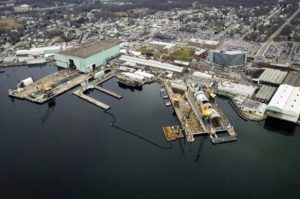General Dynamics’ Electric Boat [GD] and a union at its Groton, Conn., shipyard agreed to a new five-year agreement that will increase compensation for employees.
The Metal Trades Council (MTC) announced it ratified the new collective bargaining agreement on Oct. 6, effective Sept. 30. MTC represents over 3,400 skilled trades employees at the yard like welders, electricians, machinists, pipefitters, laborers, painters, transportation services and administration support.

The agreement will have GD EB increase wages for all MTC employees at 21.4 percent total over the five-year contract term. It will also include retention and sign-on bonuses, a one-time 401k retirement account contribution, more vacation and paid sick days, and continuing the medical plan with “modest premium and deductible increases,” the company said.
The union called this the “largest wage compensation packing in over 30 years.”
President of GD Electric Boat Kevin Graney argued this is the largest wage package in more than 30 years and “demonstrates the value we place on the skills and experience necessary to build the world’s finest submarines. This investment in our people complements investments by General Dynamics in our facilities and infrastructure and is a key element of our strategy to grow our production rate to deliver more submarines faster to the U.S. Navy.”
Rep. Joe Courtney (D-Conn.), who represents the district with the shipyard, also welcomed the deal.
“Ratification of this robust contract is a five-year ironclad guarantee of economic security for the Electric Boat metal trades workforce, which they richly deserve. It also sends a powerful message to the Navy and Congress, who fund their work, that the Groton waterfront is in for the long haul as our nation grows its undersea fleet, a decades-long enterprise,” Courtney said in a statement.
He noted the union and company teams spent months concluding the contract details.
Peter Baker, president of the Metal Trades Council, said the agreement will cover current membership and help attract and retain new employees but underscored this will help maintain the workforce.
“This will also provide Electric Boat with a stable workforce that will continue to build our nation’s defense. We want to thank the membership for their support throughout the negotiations process,” Baker said in a statement.
GD EB is one of two companies that builds Virginia-class attack submarines (SSNs) with HII [HII] and is the prime contractor for the Columbia-class ballistic missile submarines (SSBN).
Navy officials in recent years have noted contractors have been unable to deliver the submarines at the pace demanded. The Navy expects to have two attack submarines delivered per year, but the rate lately has been less than 1.5 per year.
In January, former Chief of Naval Operations Adm. (Ret.) Mike Gilday said the submarine industrial base was only building about 1.2 SSNs per year (Defense Daily, Jan. 11, 2023).

In March, Secretary of the Navy Carlos Del Toro told a House panel that submarine production had already improved to 1.4 boats per year (Defense Daily, March 30).
Electric Boat is looking to increase capacity, in part, because the AUKUS agreement among Australia, the U.K., and U.S. plans to have to U.S. sell three to five new and used Virginia-class boats to Australia. Australia will use those submarines to bolster its aging Collins-class conventionally-powered diesel submarines until the newer SSN-AUKUS vessels are ready for use there by the 2040s.
The company said it plans to hire 5,750 new employees this year as it expands to increase submarine production.
Australian officials also plan to invest upward of $3 billion in the U.S. industrial base in addition to purchasing any new SSNs from the shipbuilders.